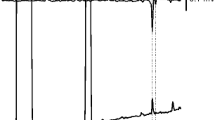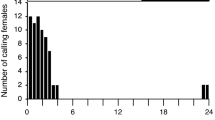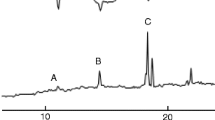Abstract
A multicomponent pheromone produced by male cabbage looper moths that is attractive to female moths in a flight tunnel bioassay was isolated and identified. Based on analyses of hairpencil extracts of male cabbage loopers and volatiles emitted by males, the pheromone has been identified as a blend consisting of (S)-(+)-linalool,p-cresol, andm-cresol. The chirality of the major component, (S)-(+)-linalool, is important for behavioral response of females. These pheromonal compounds were also identified as volatiles released by males when males were exposed to the principal pheromone component of female cabbage loopers, (Z)-7-dodecen-1-ol acetate. The amount of male pheromone released was increased significantly when males were exposed to a combination of (Z)-7-dodecen-1-ol acetate and the odor from cabbage. Neither linalool nor the cresols were detected in volatiles from cabbage or from males exposed to cabbage odor.
Similar content being viewed by others
References
Aldrich, J.R., Lusby, W.R., Kochansky, J.P., andAbrams, C.B. 1984. Volatile compounds from the predatory insectPodisus maculiventris: Male and female metathoracic scent gland and female dorsal abdominal gland secretions.J. Chem. Ecol. 10:561–568.
Aldrich, J.R., Lusby, W.R., andKochansky, J.P. 1986. Identification of a new predaceous stink bug pheromone and its attractiveness to the Eastern Yellowjacket.Experientia 42:583–585.
Bentley, M.D., McDaniel, I.N., Yatagap, M., Lee, H., andMaynard, R. 1981. Oviposition attraction and stimulants ofAedes triseriatus (Say) (Diptera: Culicidae).Entomol. Soc. Am. 10:186–189.
Birch, M.C. 1974. Aphrodisiac pheromone in insects, pp. 115–134,in M.C. Birch (ed.. Pheromones. North Holland, Amsterdam.
Birch, M.C. 1977. Response of both sexes ofTrichoplusia ni (Lepidoptera: Noctuidae) to virgin females and to synthetic pheromone.Ecol. Entomol. 2:99–104.
Birch, M.C., andHefetz, A. 1987. Extrusible organs in male moths and their role in courtship behavior.Bull. Entomol. Soc. Am. 33:222–229.
Brownlee, R.G., andSilverstein, R.M. 1968. A micro-preparative gas Chromatograph and a modified carbon skeleton determinator.Anal. Chem. 40:2077–2079.
Cornforth, R.H., Cornforth, J.W., andPrelog, V. 1962. Uben die configuration von linalool, eine berichtigung.Justus Liebigs Ann. Chem. 634:197–198.
Creighton, C.S., McFadden, T.L., andCuthbert, E.R. 1973. Supplementary data on phenylacetaldehyde: an attractant for Lepidoptera.J. Econ. Entomol. 66:114–115.
Duncan, D.B. 1955. Multiple range and multiple F. Tests.Biometrics 11:1–41.
Gaydou, E.M., andRandriamiharisda, R.P.J. 1987. Gas Chromatographic separation of linalool derivatives. Chromatography 396:378–381.
Gothilf, S., andShorey, H.H. 1976. Sex pheromones for Lepidoptera: Examination of the role of male scent brushes in courtship behaviour ofTrichoplusia ni.Environ. Entomol. 5:115–119.
Grant, G.G. 1970. Evidence for a male sex pheromone in the noctuid,Trichoplusia ni.Nature 227:1345–1346.
Grant, G.G. 1971. Scent apparatus of the male cabbage looper,Trichoplusia ni.Ann. Entomol. Soc. Am. 64:347–352.
Grant, G.G., andBrady, U.E. 1973. Topography of the scent scales of the male cabbage looper,Trichoplusia ni.J. Ga. Entomol. Soc. 8:99–106.
Grob, J.J. 1982. Band broadening in space and the retention gap in capillary gas chromatography.J. Chromtagr. 237:15–23.
Guy, R.H., Leppla, N.C., Rye, J.R., Green, C.W., Barette, S.L., andHollien, K.A. 1985.Trichoplusia ni, pp. 487–494,in P. Singh and R.F. Moore (eds.. Handbook of Insect Rearing, Vol. 2. Elsevier, Amsterdam.
Hagan, D.V., andBrady, U.E. 1981. Absence of detectable 2-phenylethanol inTrichoplusia ni, a reported pheromone of males.J. Ga. Entomol. Soc. 16:192–196.
Heath, R.R., andSonnet, P.E. 1980. Technique for in situ coating of Ag+ onto silica gel in HPLC columns for the separation of geometrical isomers.J. Liquid Chromatogr. 3(8): 1129–1135.
Jacobson, M., Adler, V.E., Kishaba, A.N., andPriesner, E. 1976. 2-Phenylethanol, a presumed sexual stimulant produced by the male cabbage looper moth,Trichoplusia ni.Experientia 32:964–966.
Landolt, P.J., andHeath, R.R. 1987. Role of female-produced sex pheromone in behavioral reproductive isolation betweenTrichoplusia ni (Hübner) andPseudoplusia includens (Walker) (Lepidoptera: Noctuidae: Plusiinae).J. Chem. Ecol. 13:1005–1018.
Landolt, P.J., andHeath, R.R. 1989. Attraction of female cabbage looper moths (Lepidoptera: Noctuidae) to male-produced sex pheromone.Ann. Entomol. Soc. Am. 82(4):520–525.
Landolt, P.J., andHeath, R.R. 1990. Sexual role reversal in mate-finding strategies of the cabbage looper moth.Science 219:1026–1028.
Masada, Y. 1976. Analysis of Essential Oil by Gas Chromatography and Mass Spectroscopy. Wiley, New York.
Mayer, M.S., andMcLaughlin, J.R. 1990. Handbook of Insect Pheromones and Sex Attractants. CRC Press, Boca Raton, Florida.
Mitchell, E.R., Webb, J.C., andHines, R.W. 1972. Capture of male and female cabbage loopers in field traps baited with synthetic sex pheromone.Environ. Entomol. 1:525–526.
Murphy, R.E. 1989. The fractionation gap: An optimized coupling of fused silica columns in open tubular gas chromatography. Master's thesis. University of Florida,
Ohloff, G., andKlein, E. 1962. Determination of configuration of linalool.Tetrahedron 18:37–39.
Ohwa, M., Kogure, T., andEliel, E.L. 1986. An asymmetric synthesis of enantiomerically pure (S)-(+)-linalool (3,7-dimethyl-l,6-octadien-3-ol) and a formal synthesis of (R)-(−)-linalool.J. Org. Chem. 51:2599–2601.
Ryan, M.F., andGuerin, P.M. 1982. Behavioral responses of the carrot fly,Psila rosa, to carrot volatiles.Physiol. Entomol. 7:314–324.
Steel, R.G.D., andTorrie, J.H. 1960. Principles and Procedures of Statistics. McGraw-Hill, New York.
Swaboda, P.A.T. 1962. Qualitative and quantitative analysis of flavour volatiles from edible fats, pp. 273–291,in M. van Swacy (ed.. Gas Chromatography. Butterworth, London.
Thornhill, R., andAlcock, J. 1983. The Evolution of Insect Mating Systems. Harvard University Press, Cambridge, Massachusetts.
Willis, M.A., andBirch, M.C. 1982. Male lek formation and female calling in a population of the arctiid moth,Estigmene acrea. Science. 218:168–170.
Wood, W.F., Leahy, M.G., Galun, R., Prestwithc, G.D., Meinwald, J., Purnell, R.E., andPayne, R.C. 1975. Phenols as pheromones of ixodid ticks: A general phenomenon?J. Chem. Ecol. 1:501–509.
Wunderer, H., Hansen, K., Bell, T.W., Schneider, D., andMeinwald, M. 1986. Sex pheromones of two Asian moths (Creatonotos transiens, C. ganges; Lepidoptera: Arctiidae): Behavior, morphology, chemistry, and electrophysiology.Exp. Biol. 46:11–27.
Author information
Authors and Affiliations
Rights and permissions
About this article
Cite this article
Heath, R.R., Landolt, P.J., Dueben, B.D. et al. Identification of male cabbage looper sex pheromone attractive to females. J Chem Ecol 18, 441–453 (1992). https://doi.org/10.1007/BF00994243
Received:
Accepted:
Issue Date:
DOI: https://doi.org/10.1007/BF00994243




